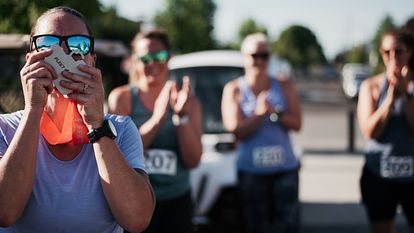How to Choose Your First (or Next) Race

When I started training for my first half marathon, I was part of a run program that did all the hard work for me: It gave me my half marathon training plan, my daily mileage and long runs—all with the end goal of getting to race day.
However, as I increased my mileage, branched out in the running community and stumbled over the road map of race day options, I found myself wondering: How do I choose the right race for me?
Maybe you’re just beginning your racing journey with your first 5K or 10K. Or maybe you're looking to go farther with a half, or even a full, marathon. Or maybe you’re a seasoned racer on the hunt for your next PR. Regardless of where you are, these are some things to consider when choosing your next race.
1. Training Weather
First, it’s important to consider the time of year you’ll be running your race as well as the weather you’ll be training in.
Often setting your sights on a fall race means you are probably hoping for cooler weather to lead you to that perfect PR. However, that means you’ll likely spend your training weeks in the height of summer, when the brilliant sunshine mingles with bouts of humidity and creates its own mental and physical obstacles for you to overcome.
On the other hand, training for a spring or summer race means slogging through winter slush, ice, snow or rain. Whatever the weather, keep it at the front of your training and race-day considerations, but don’t let it stop you from training completely.

2. Race Location
Location is also a key factor. Sometimes a vacation offers the perfect opportunity to run a race. Maybe you’re taking a trip somewhere and notice there’s a race in the area during your stay. You decide to sign up because who doesn’t love a tour of a city’s best landmarks or a country’s most beautiful terrain?
However, if this is your first race, a local race might be the best choice. Staying local allows you to find a race that suits your schedule, helps familiarize you with the course before you run it and cuts out the hassle of hotel, flight or other transportation expenses so you can stay focused on the race ahead.
3. Elevation
Another key feature that can add excitement to a race is elevation and elevation change—or lack thereof.
A flatter course is your best option for a strong race day PR. Hilly courses are great for strengthening different muscles and increasing your heart rate—plus you’ll get more variety in your race course—but they’re not great for fast times.
If you’re looking for extra elevation, trail races are excellent options. Browse the race’s website for insightful tips and key points, including course elevation, to help you decide if that race is right for you.

4. Popularity/Price
Popular races are great options for many first-timers since they let you get lost in a sea of new running friends. There’s also tons of support throughout the course, and they can come with excellent finish line perks aside from the medal (although that alone could lure you to run a half).
However, not everyone likes this type of environment. Plus, the more popular a race is, often the pricier it’ll be to run it.
Low-key races have their own rewards, though. For example, a less populated race means less time spent weaving through runners at the start—important if you’re trying to PR.
Trail races offer unrivaled scenery and the chance to connect with nature. Less popular road races also allow you to focus on your zen or get to that finish line for the first time without added pressure from the entire city.
Also, it’s important to note that whatever race you choose, the earlier you register the better. Prices increase as race day gets closer, so taking advantage of an early bird special could mean more cash in your wallet to spend later.
5. Where to Find a Race
If you’re wondering where to find your next (or first) race, these websites might be good places to start. They all offer easily searchable databases and hundreds of races, both within the United States and around the world:
Of course, word of mouth from others in the running community, social media posts, and advertisements in running stores and around a community are other great ways to discover races.
Whatever you choose, be sure to enjoy the race—you trained hard, after all.



Join our Newsletter
Get deals, events, and more.
Connect with Fleet Feet
Get involved on social media.
Find a Location
Fleet Feet has over 250 locations nationwide!
Find a Store